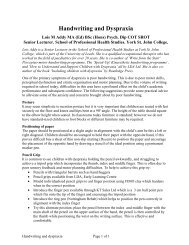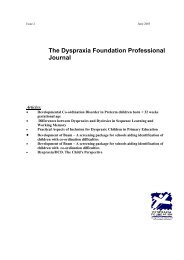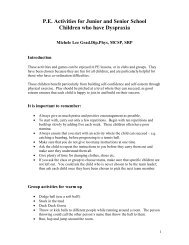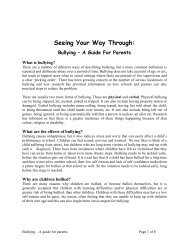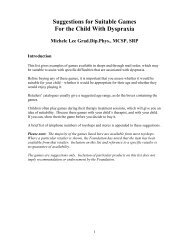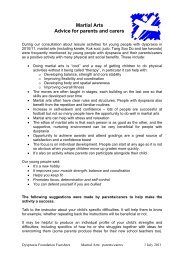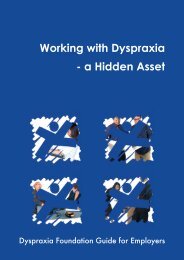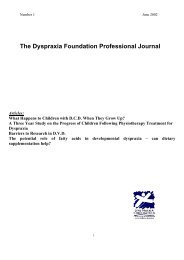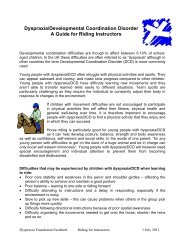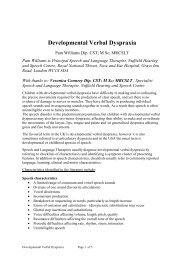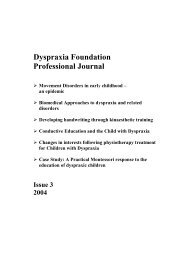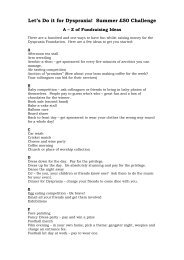Developmental Verbal Dyspraxia - Dyspraxia Foundation
Developmental Verbal Dyspraxia - Dyspraxia Foundation
Developmental Verbal Dyspraxia - Dyspraxia Foundation
Create successful ePaper yourself
Turn your PDF publications into a flip-book with our unique Google optimized e-Paper software.
Aims of exercise: to encourage easy rapid movements of the soft palate to close off the nasalpassages when appropriate in speech.Blowing activities encourage vigorous movements of the soft palate and will help developmuscle strength. If your child finds this very difficult and air comes down his nose, you canhelp by gently placing your thumb and forefinger under his/her nostrils – this will help closeoff the air stream and give him the feeling of air coming through his mouth and is morepleasant for the child than if you pinch his/her nostrils.Blowing bubbles – a wand is difficult so use a simple blower (a variety are available in toyshops)Blow painting through straws can be fun, if messy!Blowing pipes, recorders, harmonicas, etc., is enjoyable and rewarding.Blowing games are often enjoyed and will motivate him to try again – various blowing gamescan be found in toyshops as well as blow football (you can improvise with straws and cottonwool, paper or a table tennis ball).If your child tends to bite too hard on ordinary straws or can’t close his/her lips adequatelyround a straw, try plastic tubing such as that used for wine making.4. The Larynx (voice box) is responsible for production of sound during speech. Thesound is produced by air passing through the vocal chords to produce vibration. If thesemovements are weak or poorly co-ordinated the voice may be too quiet or loud, the pitch maybe too high or low, and the voice may be husky or sound weak.Aims of exercises: to improve the strength and quality of vocal tone. When encouragingyour child to use a better voice, it is important to ensure that you do not create vocal strain –just asking him to make a louder sound may result in him shouting and becoming evenhuskier.Encourage singing – using his voice with music in any way he can. A good way to motivatehim/her is to encourage dancing, clapping to music as well as singing the tune – at first don’tworry about the words, use "lala" or "ahah" or any other sound that he can manage.Play games using different voices – a baby’s, a man’s, a little girl’s, a teddy bear’s, amouse’s, other animals etc. – this helps teach control of pitch.5. Breath Control is the basis of all speech production. Speech is produced on exhalation(breathing out) and may be adversely affected by weak shallow breathing, an inability tocontrol breathing out for long enough to produce a phrase or sentence, or poor co-ordinationof breathing and speech patterns.Aim of exercises: to encourage good easy breathing for speech.a) Encourage your child to make a sound (e.g. “ah” or “ee” or “oo”), first of all for a shorttime and then gradually increasing the length of the breath and sound. Some visual cue willhelp him – run a toy car, or an animal or your finger along a line, or through amaze etc.b) Using a blowpipe and ball (available in different forms from toyshops) try to keep the ballrevolving in the air for an increasing length of time.These suggestions should give you ideas on how to help your child become aware of thestructures and movements needed for speech production and help him gain some control ofthem.<strong>Developmental</strong> <strong>Verbal</strong> <strong>Dyspraxia</strong> Page 4 of 5



